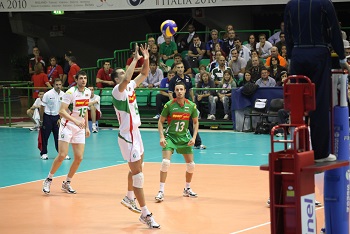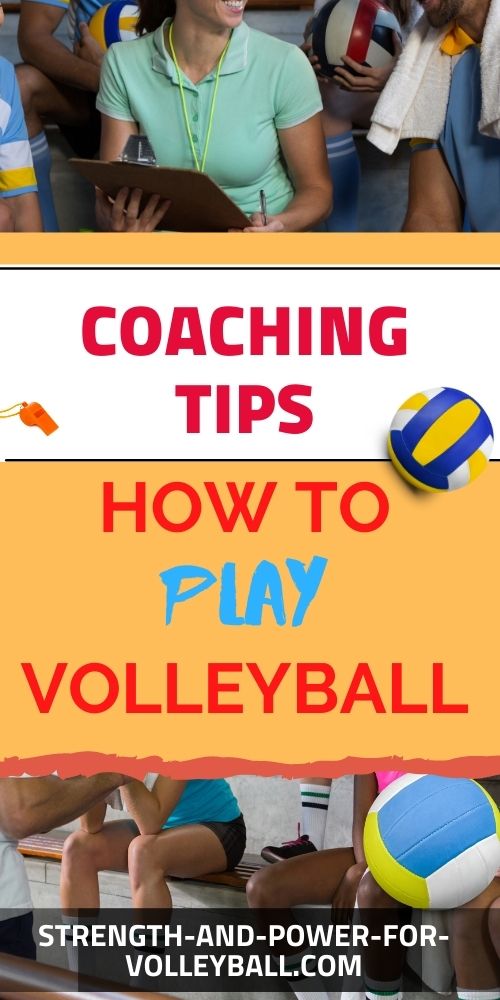How to Play Volleyball
Skills, Positions, Rules, and Strategy
When first learning how to play volleyball, you need to understand the object of the game. The object of the game is to beat your opponents to a predetermined number of points.
In the old days, volleyball was played to 15 points and a point is scored only when the serving team wins the rally.
Today, rally scoring is primarily used which means a point is scored as a result of each play. Most volleyball games today are rally scoring and played to 25 points.
To win the game, you must score more points than your opponent and be leading by at least 2.
Winning the Rally
When first learning how to play volleyball, it's important to understand how to score points.
To score a point in volleyball, a team must win a rally. A rally is begun by a server serving the ball into play. The ball is served over the net to the opposing team.
The opponent then gets a maximum of three hits to return the ball back over the net.
A team wins a rally if...
- there opponent isn't able to successfully return the ball
- a player hits the ball down into their opponents court
- a player hits the ball out of bounds
- the team hits the ball off an opposing player
- a player commits a fault when playing the ball
If you enjoyed these tips on how to play volleyball and would like to keep it close to you at any time, just save this pin to your Pinterest Volleyball Training Board.
Basic Rules
Indoor volleyball is played with two 6 player teams. Each team has 3 front row players and 3 back row players. The front row players mainly hit and block. The back row players mainly pass and dig.
The teams are separated by a net over which the ball must cross.
In the mens game, the net is positioned to 2.43 meters high.
In the womens game, the net is positioned to 2.24 meters high.
Basic Skills
There are some basic volleyball skills and court positions that you must know before you start playing volleyball.
The skills listed here are just basic.
The basic skills for playing volleyball are serving, passing, setting, attacking, blocking and digging.
The serve is what begins the game.
Passing the ball is the skill that's performed by the player receiving the ball.
Setting is the action of playing the ball to a teammate. Setting is usually done in an overhead motion using the hands. Players that have a hard time getting in good position to hand set may elect to set using a forearm passing motion. This is called bump setting.
Attacking or spiking is the action of sending the ball over the net to the opponent's court. Attacks are usually done by taking steps to approach the net to jump and hit the ball. The volleyball approach and hit is often thought of as the most fun skill in volleyball.
A block is the action of trying to prevent the ball from crossing the net into your court.
Digging is the action of playing the ball in a way that prevents the ball from touching the court after an attack by the opponents.
To get good at these volleyball skills require improving physical proficiency and hand-arm-and-eye coordination. Being able to effectively communicate with your teammates and having an understanding of how to play volleyball will highly influence how well you perform these skills.
The Players
On a very basic level, players on the team can be divided into 2 types.
-
Front row players (attack/blocker)
The front row players responsibility is attacking the ball when the setter sets them. Also, front row players try to block the ball coming from the opponent. -
Back row players (passer/digger)
The back row players main responsibility is to pass the ball that comes from the opponent. Back row players are the main passers on the team when receiving the opponents serve. Back row players also dig balls hit by opposing team spikers.
The Positions
Here are some basic volleyball positions you should become familiar with when learning how to play volleyball.
-
Setter
A setters main job is to set spikers. This is done by waiting for a teammate to pass the ball to them. -
Spiker
A spiker (attacker) is a player that attacks a ball over the net. The spiker is a front row player and their main job is to spike balls at the net. -
Passer
A passer is player that passes the ball up to the setter. The better a passer is able to pass, the easier it is for the setter to set which results in a better attack by the spiker. -
Digger
A digger is a defensive player that passes the ball up to the setter. The digger is skilled at digging hard driven spikes and chasing down off-speed shots by the opponent. -
Server
The server is the player on the team that puts the ball into play to start the rally. The players that understand how to play volleyball the best are often the best servers on the team.
How to Play Volleyball Related Pages
Player Roles & Positions
Volleyball positions and roles. Learn the volleyball positions and the role of each player on the volleyball team. Each player on the court has a unique role.
5-1 Formations Tips
Volleyball formations 5-1 serve receive and tips for how to rotate in volleyball. Learn advantages to the 5-1, 6-2, and 4-2 systems.
How to Run a 4-2 Offense
Volleyball formations 4-2 for running a volleyball 4-2 offense. Watch this volleyball video on volleyball rotations and volleyball overlaps.
How to Run a 6-2 Offense
Volleyball formations 6-2 offense. To win in volleyball your team needs an offensive volleyball system. The 6-2 rotation is the most common strategy.
Short Player Tips
Too short for volleyball? You might be worried you can't compete with taller players. The fact is, height is as big a deal in volleyball. Yes, there's an advantage
Pepper Tips
How to pepper in volleyball. Learn the pepper drills and best way to pepper with a partner. Volleyball pepper for pass, set, hit. Control partner drills for practice.
Scholarships
Top
10 things you need to do to get a scholarship for volleyball. How to get an NAIA scholarship for volleyball. What coaches want and what you can do
to impress...
Hitting Smarter
Hitting
smarter and techniques for spiking. Tips for jousting and beating the
blocker. Do you broad jump into the ball? Or do you focus on jumping
more straight up and getting high?
Coaching Youth
Coaching
youth can be a very challenging task. While striving to win
is an objective, it's not the main goal for volleyball at the beginning
level...
Court Dimensions
Official
volleyball court dimensions for volleyball. Volleyball court rules and
regulations for net height, center-line, attack line, free zone, and
volleyball court specifications
How to Spike
Learn
how to spike. The basics of volleyball attacking including
the volleyball approach, 3 step approach, 4 step approach, how to
contact the ball...
How to Pass
Learn
how to pass. The basics of volleyball passing including the
forearm pass, overhead pass, body position, foot position, angle of the
arms...
How to Serve
How
to serve isn't as complicated as many player's think.
Underhand serves are the most popular types of serves for beginners.
Overhand topspin and float serves are...
Setting
Setting can be difficult to learn if you don't know proper
technique. Good hand position, contacting the ball on all the fingers,
setting without...
Formations
U
formation using four players and the w formation using five players are
the most popular serve receive formations. The two most important
considerations...
Four Player Receive
Four
player serve receive formations, u shape, semi moon,
staggered left, staggered right. The U formation is more common for
skilled..
Three Player Receive
With
the three person receive alignment it's much easier to
communicate and the three best passers can pass in each rotation. Only
having...
Tips for Blocking
Blocking is the most under taught skill. The idea is simple, jump up and reach high over the net. Reading the setter and hitters...
Training Gear
List of important gear and equipment you need to be successful at volleyball...
Attack Line Rules
Attack line in volleyball and everything you need to know about the attack line. Back row attacks, libero setting, and substitutions rules. What you need to know.
How to Attack
How to attack in volleyball. Tips for attacking and how a volleyball attack is defined. Why attack and strategies to help a team create a successful offense.
3 Setting Skills to Master for Setting a Volleyball
What is setting in volleyball? Discover how to become a great volleyball setter with these 3 setting skills that will help you master your volleyball setting.
4 Critical Passing Mistakes
What is passing in volleyball and the common mistakes volleyball players make when learning to pass. Avoid these critical errors. Do you make these mistakes? Learn how to fix them today!
Volleyball › How to Play Volleyball
- Home
- How to Play

